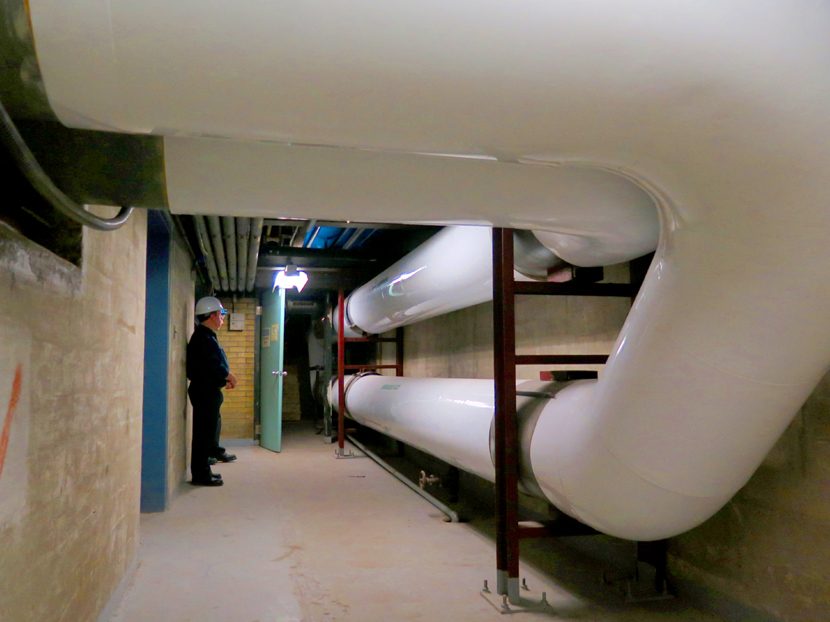Viral Stories of Failure and Triumph
Proper installation of pipe insulation is good for business.

We now live in a world where the mainstream media and social media are serving up daily news less distinguishable from entertainment than ever before. The valuable currencies in the information age seem to be surprise, shock and outrage, with each story more incredible than the last.
The wider world can seem to be a burlesque of irrationality compared to our mundane, daily grind in the plumbing and HVAC field. Yet if we look for it, we find a stream of exciting innovations and incredibly crazy incidents in our realm, too.
One behavior that might not seem shocking relates to the otherwise inconspicuous field of pipe insulation. Believe it or not, it’s dramatic and dynamic. Consider how mechanical rooms have changed in appearance with multicolored insulation, as well as jacketing wrapped neatly around pipe and directional labels affixed for liquid and steam systems.
More Instagram-worthy are the incredible number of mechanical rooms that do not look like this. They’re not updated in any way. The pipe is improperly insulated or not insulated at all. These situations do indeed fall into the same category as the nuttiest YouTube video or Twitter photo if we consider the cost of not properly employing modern pipe insulation technologies. It’s incredibly expensive and foolish for building owners, as well as for those of us in the trade who are supposed to be helping them.
Unrivaled ROI
Studies indicate that when constructing a building costs $25 million, operating the building over its lifetime costs an average of another $75 million if properly insulated. The cost shoots up to $90 million when not insulated. The cost of the insulation is usually recovered within the first year; however, the National Insulation Association (NIA) conservatively estimates the average return on investment in insulation is six months to two years.
“Insulation is a proven means for saving energy, reducing greenhouse gas emissions, increasing process productivity, providing a safer and more productive work environment, controlling condensation (which can lead to mold growth), supporting sustainable design technology, and a host of other benefits,” the organization said. “It does all this while providing an ROI that is seldom rivaled.”
To make insulation planning easier for pipe contractors, engineers and facilities professionals, the North American Insulation Manufacturers Association (NAIMA) has been continuously updating its 3E Plus app and its library of literature on pipe insulation codes and standards.
“3E Plus does sophisticated heat transfer algorithms based on the ASTM C680 standard,” said Charles Cottrell, executive director of NAIMA. “It allows custom inputs for your job and provides default values if your exact numbers aren’t available. Product selections are based on K-values.”
3E Plus helps you determine the most economical thickness of insulation for required efficiencies, condensation control and personal protection. It helps calculate temperatures, energy costs, installed costs and greenhouse gas emissions.
“It shows savings in BTUs and dollars,” Cottrell noted. “We’re adding new materials, pipe types and other technologies all the time.”
Keeping abreast of new products and materials can make a difference for unexpected reasons. At a medical center in McKinney, Texas, the constant rain threatened the construction schedule. Rainwater was collecting on the floor slabs, so holes were drilled through them to drain it off. This is a nightmare situation for insulators hoping to keep things dry, but the pressure was on to complete the mechanical systems.
Art Navarrete, vice president of Texoma Industrial Insulation, specified a Knauf product that allowed the company to start months earlier than expected and avoid overtime costs. It’s called Earthwool 1000° ASJ+ and is composed of aluminum foil, reinforced with glass scrim bonded to a kraft paper interleaving with an outer layer of film which leaves no paper exposed.
Costly Mistakes
It’s a good idea to get some expert help with products, design and perhaps use modern tools such as the aforementioned app because insulation mistakes can be very costly.
Bill Lotz is a nice enough man but you definitely don’t want to see him at your project site. That’s because Lotz is the guy they call when there is a serious problem. He is an insulation veteran with more than four decades of experience. After he leaves, things usually have to be ripped out and it often costs a great deal of money. It usually happens as a result of someone trying to save money or time, but generally lose more of both.
“I was on one job in Austin Texas; five buildings, 818,000 sq. ft. and the insulation was full of water,” Lotz said. “When they realized they had to fix it, an engineer specified new insulation at a thickness of a half inch. They don’t even make half-inch insulation because it wouldn’t be very effective. This is a serious business; replacing that insulation cost millions of dollars, so you should try to do it correctly.”
He had a similar situation in a Florida high-rise. It was a new construction project, not completed, and all the 1-in. foam insulation had to be removed because condensation was collecting on it.
“Sometimes mechanical contractors put supply and return pipes too close together,” Lotz explained. “You need 2 inches of insulation on each pipe. You need different products if your insulation is outside rather than inside. Otherwise, you’ll be painting it every few years.”
Many times, he sees building owners or facility managers ignore problems. A university dormitory in Maine had chilled water piping that was incorrectly insulated; within 10 years, the insulation was filling up with condensation every year. The acoustic ceiling tiles would get stained and the school would replace them before the students arrived.
“One year the humidity was higher and lasted longer,” Lotz recalled. “A few students arrived early, before they had done the tiles, and there was mold everywhere. The press was called and the whole thing blew up. Not only did they have to replace all the insulation but they also had to hire 130 Servpro workers to come in and clean everything up in record time. They were at the school 24/7, scrubbing every surface. Someone had to pay for that.”
Job From Hell
Insulators are paid well, are continuously in demand and the industry is flourishing. Since the 2008 recession, the trend line has been more and more positive. It’s growing in the double digits and NIA President Dan Bofinger believes the trend will continue through 2019. As in many trades, there is a shortage of qualified insulation installers.
Still, there are some jobs where the phrase, “You can’t pay me enough,” seems to apply. One of these took place a few years ago at a hospital in northern Toronto. It’s a high-traffic facility managing between 400,000 and 500,000 patient days each year. More than a dozen buildings have service tunnels running beneath them across the campus from the boiler plant.
One reason for upgrading insulation was that as the hospital grows, everything needs development, modification and maintenance. Systems need to be isolated and serviced or expanded quickly. Below ground are lines for steam, condensate, chilled water, medical air, medical vacuum, oxygen, nitrous oxide, compressed air and natural gas.
The tunnels containing the lines are ancient, cramped and, in some cases, unsafe, with numerous workers coming and going. Additionally, many sections contained asbestos, which creates time-consuming procedures and protocols to avoid human hazards. Eventually, the decision was made to replace all the insulation, which was approaching the end of its effective life in any case.
The installation was challenging. They would have to remove and replace about 2,800 linear feet of steam pipe (6 in. to 12 in.); 5,600 feet of chilled water; and 5,600 feet of heating lines. The piping runs close together, making it difficult to remove the old and install the new insulation. The schedule was ambitious because the government provided funding with a deadline that required working six days each week for most of the installers.
Additionally, when the asbestos was removed from the steam lines, the temperature in the tunnels increased to between 122 F and 158 F. The floors were so hot that nurses and patients in the corridors above thought buildings were on fire. The plan was to remove and replace in 50-ft. sections.
Reinstallation alone took about one week per 50-ft. section. Because of the high temperatures and confined space, installers would work 15 minutes on, 15 minutes off, wearing full face masks and Tyvek suits. Safety meetings were held daily to review heat exhaustion and heat stress symptoms and prevention. A buddy system was used to ensure that no one was ever working alone in the tunnels.
A relatively new product called Pyrogel was specified to overcome the lack of space between lines — highly engineered, provides about twice as much energy efficiency, repels water and is still breathable enough to release vapor and prevent corrosion. It could meet modern energy standards with less thickness.
Pyrogel is applied in layers and comes in blankets. It can be cut to fit anything but it’s dusty work. For this job, installers completed the cutting in separate areas. Workers discovered they had to wash their skin three or four times each night to remove the dust.
Other innovations in the insulation business include formaldehyde-free systems, greener products such as Eco Fibre, rubber for cold water, systems for plastic lines and more.
The healthier systems can’t get here fast enough from the installers’ point of view, toiling away in those hospital dungeons. Miles of pipe, insufferable heat, cramped, dirty tunnels, chemical dust that sticks to your skin — what a job! But they got ‘er done and achieved all the designer’s goals.
That’s because insulators they are surprising, shocking and outrageous professionals. We should be tweeting about them!





